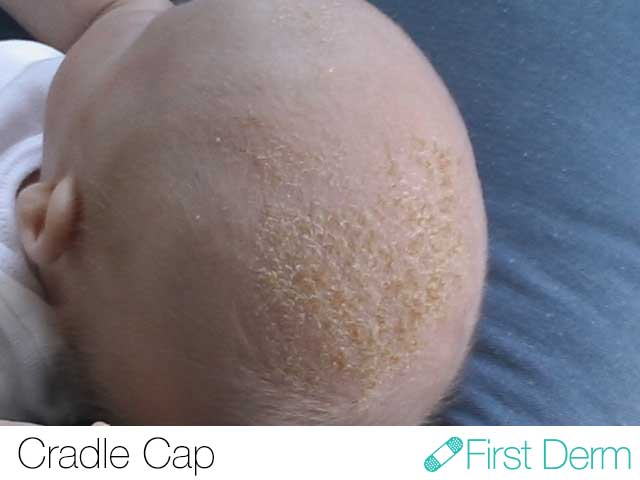Cradle Cap (Seborrheic dermatitis)
Medically reviewed by The Dermatologists and written by Dr. Alexander Börve
More than 200,000 US cases per year
- Often self-diagnosisable
- Symptoms: Scales on the scalp
- Color: Typically yellow-brown
- Location: Scalp
- Treatment: No treatment necessary, lubrication with mild shampoo
ICD-10: L21.0
ICD-9: 690.11
Cradle cap is the thick, yellow-brownish spots that often appear on the scalp in babies. It is sometimes known as milk crust, because the affected skin can feel crusty, and comes off in small, dandruff-like flakes. Milk crust is a misnomer–cradle cap has nothing to do with the baby being fed on milk.

Cradle Cap in a newborn or toddler, illustrating the common symptoms of Seborrhoeic Dermatitis with scaly, crusty patches on the scalp.
Similar skin lesions may also appear on the forehead, face, elbows, buttocks or in the skin underneath the diapers. These kinds of conditions are categorized as eczema. Underneath the spots, the skin is red and irritated. Even though cradle cap is completely harmless and not contagious, many parents want to try to get rid of it because it looks unpleasant.
Try our FREE dermatology search engine and get peace of mind within a second
Symptoms of Cradle Cap
Cradle Cap, or infantile Seborrheic Dermatitis, is a common condition among newborns and typically resolves by six months of age. The symptoms include:
- Appearance on Scalp: Patchy scaling or thick crusts are commonly seen on the scalp.
- Skin Texture: The affected skin can be oily or dry and is often covered with flaky white or yellow scales.
- Additional Areas Affected: Apart from the scalp, similar scales might be present on the eyebrows, around the ears, eyelids, nose, and in areas like the neck folds, armpits, and groin.
- Skin Reaction: The child’s skin in these areas can appear reddened. However, Seborrheic Dermatitis is typically not itchy and does not cause discomfort or irritation to the child.
- Contagiousness: It is important to note that Seborrheic Dermatitis is not contagious.
Differential Diagnosis of Cradle Cap
Cradle Cap is sometimes mistaken for another skin condition, atopic dermatitis (a form of eczema). The key difference is that atopic dermatitis is often very itchy, unlike Cradle Cap.
What can I do?
If the affected area is small and you would like to remove cradle cap, you can rub the baby’s scalp with baby oil at night. In the morning, you should wash the scalp with a mild, unscented baby shampoo. After that, you rub the scalp gently with a towel or with products containing borage oil to remove the crust. The oil is usually available in pharmacies. Repeat the treatment if the problem recurs.
If the child’s cradle cap is stuck, you can lubricate the evening with salicylic acid to soften the crust. They are available without prescription at most pharmacies. In the morning, gently remove the crust with a towel, brush or comb. Then, wash the hair with a mild, unscented baby shampoo. This treatment may need to be done several times.
If you want to protect the bedding, you can put a towel or a thin cap over the baby’s head.
When to Seek Medical Care for Cradle Cap?
Consult your baby’s healthcare provider in the following situations:
- Lack of Improvement with Home Treatment: If you’ve attempted home remedies for cradle cap without success, it’s advisable to seek professional advice.
- Spread of Patches: If the cradle cap spreads beyond the scalp to the baby’s face or body, a medical evaluation is necessary.
- Use of Mild Cortisone Cream: In cases where you have applied mild cortisone cream for about a week without any noticeable improvement, it’s important to contact your healthcare provider.
- Presence of Itching: Although cradle cap typically doesn’t cause discomfort, if the affected area becomes itchy, this warrants a medical consultation.
Treatment
It usually disappears by itself, but it can also turn into what is called seborrheic dermatitis or dandruff eczema.
If you absolutely want your child to get rid of cradle cap, try the following:
Wash your child’s hair with a mild baby shampoo and remove the softened scurf with a small, soft brush or a fine comb. If the crust is very firm, rub a little Vaseline or a few drops of olive oil into the baby’s scalp and leave overnight before washing the hair and scalp.
Try our FREE dermatology search engine and get peace of mind within a second
Last updated on January 11, 2024
References
- Sheffield RC, Crawford P, Wright ST. What’s the Best Treatment for Cradle Cap? J Fam Pract. 2007;56(3):232-233. Available from: https://www.mdedge.com/familymedicine/article/62596/pediatrics/whats-best-treatment-cradle-cap.
- American Academy of Dermatology Association. How to Treat Cradle Cap. Updated August 17, 2022. https://www.aad.org/public/everyday-care/hair-scalp-care/scalp/treat-cradle-cap.
- Stein S. What is Cradle Cap? American Academy of Pediatrics Section on Dermatology. Last Updated October 19, 2023. Available from: https://www.healthychildren.org/English/ages-stages/baby/bathing-skin-care/Pages/Cradle-Cap.aspx.

The Specialist doctor from the University Hospital in Gothenburg, alumnus UC Berkeley. My doctoral dissertation is about Digital Health and I have published 5 scientific articles in teledermatology and artificial intelligence and others.

